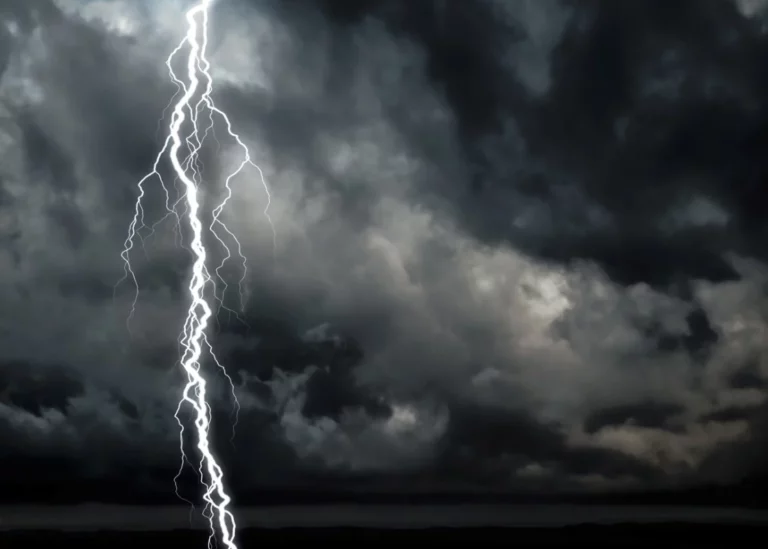Swimming Pool & Lightning Safety

While swimming in gentle rain may feel peaceful and enjoyable, thunderstorms and lightning strikes pose serious risks to swimmers. Whether you’re a seasoned or first-time pool owner, understanding lightning safety is critical to protecting swimmers from electrocution or injury from panicking, such as slipping on wet surfaces or colliding with others while exiting the pool.
Our blog from the SPS PoolCare experts is here to help you with some of the most common questions concerning pools. Is it safe to swim in the rain? Can you swim indoors during lightning storms?
Lightning is unpredictable and life-threatening, especially near water or metal, which can conduct electricity, so it’s important to have a thorough understanding of safety measures to follow when swimming during stormy weather. Read on to learn advice for monitoring the weather, practicing safety-first swimming, storm preparation tips, and what to do if you’re swimming during a lightning storm!
Is It Safe To Swim in the Rain?—The Risks of Swimming During Thunderstorms
When enjoying your pool, you should always practice safety-first swimming. This includes staying informed about the current weather, being aware of any changing environmental conditions, and understanding how to respond during a thunder and lightning storm. Lightning can travel and strike several miles from the storm cloud.
While a soft, gentle rain may appear safe, thunderstorms and lightning often develop quickly. This can lead to a dangerous situation as swimmers rush to exit the pool amid worsening weather conditions. Darkening skies, rain, and hail can also affect visibility in the pool, making it difficult for swimmers to see clearly. Rain can also increase the risks of accidents or drowning, especially in deeper pools or when multiple swimmers are present.
Water and metal structures, including handrails, diving boards, pool ladders, pool lights, and other equipment, can act as conductors for electricity during a lightning strike. When lightning strikes nearby, the electrical current can travel through these surfaces and conduct electricity through the pool water, posing a severe risk of electrocution.
Can You Swim Indoors During Lightning and Thunderstorms?
Swimming in an indoor pool during a thunderstorm is not as safe as you might think. Although there have been no reported lightning fatalities from indoor pools, it is still common for pool owners and companies to enforce the rule of no swimming during storms.
This precaution is taken to mitigate the risk of liability in the event of a lightning strike hitting the pool or building. A lightning strike could cause structural damage, shatter windows, or trigger electrical malfunctions, which could result in a lawsuit. As a result, most pools prohibit indoor swimming during storms to protect swimmers and themselves from potential legal issues.
If you are swimming indoors and lightning strikes, you should:
- Exit the pool immediately.
- Dry off entirely afterward.
- Avoid showering, bathing, or using a corded phone.
- Stay away from water sources, electrical panels, plumbing, and outlets, as these can cause lightning strikes to travel into buildings.

Storm Preparation Tips for Pool Owners
Storms accompanied by heavy winds, flash flooding, thunder, and lightning can wreak havoc on your swimming pool, making it necessary to secure it quickly to protect yourself and other swimmers. Here are some quick preparation tips for taking care of your pool before a storm:
- Do not drain the pool. The water helps secure its structure, but if drained before a heavy storm, it can lift off its foundation and cause structural damage.
- Turn off the pool equipment. Turn off the electricity from your pool’s circuit breaker to prevent lightning damage to the pumps, filters, heaters, and automation systems.
- Leave the pool uncovered. Flash flooding, heavy winds, and falling branches can damage and tear a pool cover.
- Remove loose objects. Collect and put away loose chairs, tables, toys, umbrellas, and equipment to protect them from the wind.
- Dealing with poolside electronics. Turn off and unplug your outdoor speakers, lighting, heaters, and entertainment systems, and bring what you can inside.
- Trim trees and pick up debris. Trim any precarious branches on your trees and remove them from the area. Clean up any piles of leaves and debris to prevent them from blowing into your pool and clogging your filter.
- Balance water chemistry. Balancing the water’s chemistry prepares the pool water for the upcoming storm, which helps the pool recover after the storm and prevents algae growth and pool staining.
- Brace screen enclosure, if necessary. If your pool has a screen enclosure, use braces to reinforce its structural integrity.
Implementing a Swimming Pool Safety Protocol During Signs of Lightning
Swimming during a lightning storm is extremely dangerous, as the absence of rain and a clear blue sky does not necessarily indicate safety from lightning strikes. In the western United States, dry thunderstorms frequently produce lightning without rain, and it’s not uncommon for lightning to strike over three miles away from the core of the storm and up to 10 miles from any rainfall. Plus, the erratic nature of lightning means it can strike before and after a storm has passed, making it an unpredictable and potentially hazardous force to contend with.
Familiarize yourself with these swimming pool safety protocols for when you notice signs of lightning or thunder while you’re swimming:
- Evacuate the pool quickly.
- Avoid contact with water and metal.
- Avoid open areas, high ground, trees, utility lines, flagpoles, and tall fences.
- Avoid open structures like decks, gazebos, pool houses, and tents
- Avoid touching electrical equipment, sinks, bathtubs, showers, and windows.
- Avoid leaning on concrete walls and floors.
- Use the flash-to-bang method, which involves counting the seconds between a lightning flash and the sound of thunder, to estimate how far away the storm is. For every five seconds, the storm is roughly one mile away.
- Avoid lying on the ground.
- Use the 30-30 rule to help you determine how far the storm is from you.
- Wait 30 minutes after the last clap of thunder before swimming, as lightning can strike even after a storm seems to have passed.
- Use a pool lightning detector.
- Monitor the weather closely.
Monitoring Weather Alerts
Things can move very quickly during or before a storm. If you’re swimming in your pool and you notice the skies turning threatening, hear thunder, or see lightning, exit the pool immediately and seek shelter indoors.
Continuously monitor the weather from one or more news outlets—check the weather reports from NOAA, the National Weather Service, your local news, or your favorite weather apps, like The Weather Channel or AccuWeather.
Pool Party Safety During Lightning and Thunderstorms
If you notice darkening skies, hear thunder, or see lightning, alert your guests to get out of the pool and head inside. You’ll want everyone to gather in a safe, covered, enclosed indoor space away from plumbing and windows. Encourage board games, card games, or puzzles for guests to engage with one another. You can also hand out snacks, like a charcuterie board, fresh fruit, or lollipops, to keep your guests entertained and comfortable until the skies clear.

Emergency Preparedness: What To Do When Someone Is Struck by Lightning
Acting quickly is crucial if you witness someone being struck by lightning. Immediately call 911 and check for signs of breathing or any injuries. If the person is not breathing or their heart has stopped, start CPR. It’s important to note that lightning victims do not carry an electrical charge, so there is no risk of being electrocuted when touching them. Other effects of a lightning strike can include:
- Brain damage
- Broken bones or dislocations
- Burns
- Cardiac arrest
- Difficulty sleeping and easily fatigued
- Forgetfulness and easily distracted
- Intense headache and body pain
- Issues with mental processes and multitasking
- Loss of hearing or eyesight
- Nervous system damage and seizures
- Personality changes, depression, and irritability
- Short-term memory loss
Post-Storm Pool Inspection and Cleaning
After the storm has passed and it’s safe to go outside, it’s important to inspect your pool carefully. Examine the pool’s equipment for any signs of damage, hazards, electrical shorts, or debris. Look for any potential issues caused by the lightning storm, such as electrical system malfunctions, pool water contamination, and damage to pool equipment from power surges.
Simple and Effective Post-Storm Pool Maintenance
Remember to give your pool extra love after a heavy rain or storm! Clear out all the debris from the baskets and then grab a net or pool vacuum to remove any remaining debris quickly. This simple step will clear your pool water, preventing it from turning green or cloudy.
Grounding and Bonding the Pool’s Electrical System
To prevent lightning strikes in your pool, consider implementing proper grounding and bonding of the pool’s electrical systems. This involves effectively grounding and bonding all electrical components associated with the pool to reduce the risk of electrical surges and shocks during a lightning strike. The process of grounding diverts electrical currents into the earth, while bonding connects metal components to a common ground to prevent electrical shocks.
Consult with your SPS PoolCare technician to learn more about this service and determine whether your pool’s electrical systems comply with safety standards.
Staying Safe During a Lightning Storm From SPS PoolCare
Our extensive guide provides in-depth information on various weather conditions to be mindful of, along with detailed insights on whether it’s safe to swim during rainfall. By following our comprehensive tips from SPS PoolCare, you can have fun and stay safe while swimming throughout all seasons of the year.
Was your pool recently affected by a thunderstorm, lightning strike, monsoon, or hurricane? Find the nearest SPS PoolCare service area to you, or fill out a contact form online to learn more about our comprehensive pool servicing, repairs, cleaning, and maintenance options. Visit our swimming pool blog and news pages for more details about our services!





